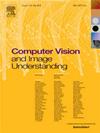NeRFtrinsic Four: An end-to-end trainable NeRF jointly optimizing diverse intrinsic and extrinsic camera parameters
IF 4.3
3区 计算机科学
Q2 COMPUTER SCIENCE, ARTIFICIAL INTELLIGENCE
引用次数: 0
Abstract
Novel view synthesis using neural radiance fields (NeRF) is the state-of-the-art technique for generating high-quality images from novel viewpoints. Existing methods require a priori knowledge about extrinsic and intrinsic camera parameters. This limits their applicability to synthetic scenes, or real-world scenarios with the necessity of a preprocessing step. Current research on the joint optimization of camera parameters and NeRF focuses on refining noisy extrinsic camera parameters and often relies on the preprocessing of intrinsic camera parameters. Further approaches are limited to cover only one single camera intrinsic. To address these limitations, we propose a novel end-to-end trainable approach called NeRFtrinsic Four. We utilize Gaussian Fourier features to estimate extrinsic camera parameters and dynamically predict varying intrinsic camera parameters through the supervision of the projection error. Our approach outperforms existing joint optimization methods on LLFF and BLEFF. In addition to these existing datasets, we introduce a new dataset called iFF with varying intrinsic camera parameters. NeRFtrinsic Four is a step forward in joint optimization NeRF-based view synthesis and enables more realistic and flexible rendering in real-world scenarios with varying camera parameters.
NeRFtrinsic Four:端到端可训练 NeRF,联合优化各种内在和外在相机参数
利用神经辐射场(NeRF)进行新视角合成,是目前从新视角生成高质量图像的最先进技术。现有方法需要外在和内在相机参数的先验知识。这就限制了它们在合成场景或现实世界场景中的适用性,因为它们必须进行预处理。目前关于相机参数和 NeRF 联合优化的研究主要集中在改进有噪声的外在相机参数上,通常依赖于对内在相机参数的预处理。更多的方法仅限于覆盖单个相机内在参数。为了解决这些局限性,我们提出了一种新颖的端到端可训练方法,称为 NeRFtrinsic Four。我们利用高斯傅立叶特征来估计外在相机参数,并通过投影误差的监督来动态预测变化的内在相机参数。我们的方法在 LLFF 和 BLEFF 上的表现优于现有的联合优化方法。除了这些现有的数据集之外,我们还引入了一个名为 iFF 的新数据集,该数据集具有变化的内在相机参数。NeRFtrinsic Four 是在基于 NeRF 的联合优化视图合成方面向前迈出的一步,可在相机参数变化的真实世界场景中实现更逼真、更灵活的渲染。
本文章由计算机程序翻译,如有差异,请以英文原文为准。
求助全文
约1分钟内获得全文
求助全文
来源期刊

Computer Vision and Image Understanding
工程技术-工程:电子与电气
CiteScore
7.80
自引率
4.40%
发文量
112
审稿时长
79 days
期刊介绍:
The central focus of this journal is the computer analysis of pictorial information. Computer Vision and Image Understanding publishes papers covering all aspects of image analysis from the low-level, iconic processes of early vision to the high-level, symbolic processes of recognition and interpretation. A wide range of topics in the image understanding area is covered, including papers offering insights that differ from predominant views.
Research Areas Include:
• Theory
• Early vision
• Data structures and representations
• Shape
• Range
• Motion
• Matching and recognition
• Architecture and languages
• Vision systems
 求助内容:
求助内容: 应助结果提醒方式:
应助结果提醒方式:


